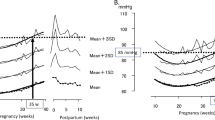Summary
The mean arterial blood pressure is decreased during the first two trimesters of pregnancy and increases to preconceptional values during the last weeks of gestation. The heart rate increases during the whole course of pregnancy. During late gestation fewer patients show an increase in diastolic blood pressure and heart rate in the standing position. A fall in heart rate was only seen in this period. A fall in mean arterial blood pressure during standing is not related to the blood pressure in the supine position during the whole course of pregnancy. The hypotensive symptoms are twice as frequent during early pregnancy compared to late pregnancy. Headaches, fatigue and cold extremities are the most usual complaints. The frequency and intensity of these three symptoms decrease during gestation. Blood pressure in the supine position is reduced in symptomatic pregnant women. However, the occurrence of these symptoms is not correlated to the fall in blood pressure in the standing position. The Birth-weight is not influenced by blood pressure in the supine position, but depends on the fall in blood pressure during standing. Pregnant women with a more pronounced fall in blood pressure give birth to newborns with a lower birthweight. These results imply a hitherto unknown cause of intrauterine growth restriction.
Zusammenfassung
Der mittlere arterielle Blutdruck ist in den beiden ersten Trimestern der Gravidität erniedrigt und steigt in den letzten Wochen der Schwangerschaft wieder auf präkonzeptionelle Werte an. Die Herzfrequenz nimmt während der gesamten Schwangerschaft kontinuierlich zu. In der Spätschwangerschaft geht der Anteil der Patientinnen mit einem Anstieg des diastolischen Blutdruckes wie auch der Herzfrequenz in Orthostase zurück; ebenso ist nur in diesem Zeitraum ein Herzfrequenzabfall zu beobachten. Die subjektiven Symptome, die mit einem hypotonen Beschwerdebild im Zusammenhang stehen, treten bei Patientinnen in der Frühschwangerschaft etwa doppelt so häufig auf wie in der Spätschwangerschaft. Überdurchschnittlich häufig anzutreffen sind Kopfschmerzen, Müdigkeit und kalte Extremitäten. Die Häufigkeit dieser 3 subjektiven Symptome und ihre Intensität gehen mit dem Gestationsalter zurück. Das Auftreten von subjektiven Symptomen ist nicht mit dem Blutdruckabfall im Stehen korreliert. Das kindliche Geburtsgewicht ist nicht vom Ruheblutdruck abhängig, sondern wird vom Blutdruckabfall in der Stehphase beeinflußt. Schwangere mit dem ausgeprägtesten Blutdruckabfall im Stehen gebären leichtere Neugeborene. Dieses Ergebnis weist auf eine weitere Ursache für die Entwicklung einer fetalen Wachstumsretardierung hin.
Similar content being viewed by others
Author information
Authors and Affiliations
Rights and permissions
About this article
Cite this article
Hohmann, M., Künzel, W. Blood pressure and heartfrequency changes in pregnancy – Value of hypertonia. Gynäkologe 32, 426–431 (1999). https://doi.org/10.1007/PL00003250
Published:
Issue Date:
DOI: https://doi.org/10.1007/PL00003250




